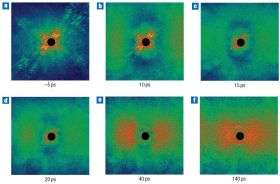FLASH Imaging Redux: Nano-Cinema is Born

Flash imaging of nanoscale objects undergoing ultrafast changes is now a technical possibility, according to a recent paper published in the June 22 edition of Nature Photonics. The results are a direct precursor to research that will be conducted using SLAC’s Linac Coherent Light Source (LCLS).
The experiments, carried out by a team of researchers that included SLAC scientists Sebastien Boutet, Janos Hajdu and Mike Bogen, used the Free-Electron Laser in Hamburg (FLASH laser) at Deutsches Elektronen-Synchrotron (DESY) in Germany.
To create the images, an artificial sample—a silicon nitride wafer less than one thousandth the width of a human hair and etched with a simple nanoscale pattern—was shot with an optical laser, which ultimately caused the tiny wafer to explode. But less than a few billionths of a second (picoseconds) after the first laser—before the sample actually had a chance to disintegrate—a second, soft X-ray laser captured an image of the sample as the disintegration process began.
By repeating the experiment with slight variations in timing between the two lasers, the researchers captured a sequence of images that follow the changes occurring in the sample as it explodes.
Similar to FLASH, the LCLS at SLAC will create ultrafast pulses of coherent X-ray laser light. Pulses from the LCLS, however, will fall in the hard X-ray range, which has a much shorter wavelength, enabling single-shot imaging of even smaller objects, on the scale of individual molecules.
Source: by Brad Plummer, SLAC





















